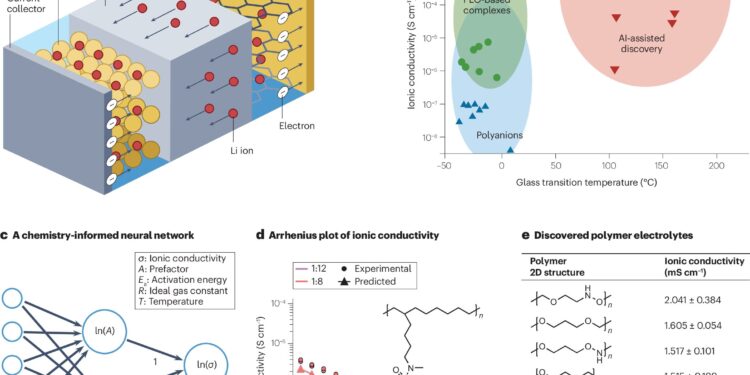Polymers for lithium-ion batteries. Credit: Nature Reviews Materials (2024). DOI: 10.1038/s41578-024-00708-8
Nylon, Teflon, Kevlar… These are just a few of the most famous polymers, large-molecule chemical compounds, that have changed the world. From Teflon-coated frying pans to 3D printing, polymers are essential to creating the systems that make the world work better.
Finding the next breakthrough polymer is always a challenge, but Georgia Tech researchers are now using artificial intelligence (AI) to shape and transform the future of the field. Rampi Ramprasad’s group develops and adapts AI algorithms to accelerate materials discovery.
This summer, two articles published in the Nature The family of journals highlights significant advances and successes from years of research in AI-driven polymer computing.
The first, presented in Nature Reviews Materialspresents recent advances in polymer design in critical and contemporary application areas: energy storage, filtration technologies and recyclable plastics. The second, published in Nature Communicationsfocuses on using AI algorithms to discover a subclass of polymers for electrostatic energy storage, with the designed materials undergoing successful synthesis and laboratory testing.
“In the early days of AI in materials science, propelled by the White House Materials Genome Initiative more than a decade ago, research in this area was largely driven by curiosity,” said Ramprasad, a professor in the School of Materials Science and Engineering.
“It is only in recent years that we have begun to see tangible, real-world successes in accelerated polymer discovery using AI. These successes are now inspiring significant transformations in the landscape of industrial materials research and development. That is what makes this study so important and timely.”
Opportunities of AI
Ramprasad’s team has developed revolutionary algorithms that can instantly predict polymer properties and formulations before they are physically created. The process begins by defining application-specific property or performance criteria.
Machine learning (ML) models rely on existing data about material properties to predict desired outcomes. Additionally, the team can generate new polymers, whose properties are predicted using ML models.
The best candidates meeting the target property criteria are then selected for real-world validation through synthesis and laboratory testing. The results of these new experiments are integrated with the original data, allowing further refinement of the predictive models in a continuous iterative process.
While AI can accelerate the discovery of new polymers, it also presents unique challenges. The accuracy of AI predictions depends on the availability of rich, diverse, and large initial datasets, making data quality paramount. Furthermore, designing algorithms that can generate chemically realistic and synthesizable polymers is a complex task.
The real challenge begins after the algorithms make their predictions: proving that the designed materials can be made in the lab and perform as expected, and then demonstrating their scalability beyond the lab for real-world use.
Ramprasad’s group designs these materials, while their fabrication, processing, and testing are performed by collaborators at various institutions, including Georgia Tech. Professor Ryan Lively of the School of Chemical and Biomolecular Engineering frequently collaborates with Ramprasad’s group and is a co-author of the paper published in Nature Reviews Materials.
“In our day-to-day research, we make extensive use of machine learning models developed by Rampi’s team,” Lively said.
“These tools accelerate our work and allow us to explore new ideas quickly. This embodies the promise of ML and AI, because we can make model-driven decisions before spending time and resources exploring concepts in the lab.”
Using AI, Ramprasad’s team and his collaborators have made significant advances in a variety of areas, including energy storage, filtration technologies, additive manufacturing and recyclable materials.
Progress in the field of polymers
A notable success, described in the Nature Communications The project, which focuses on designing new polymers for capacitors, which store electrostatic energy, is a critical component of electric and hybrid vehicles, among other applications. Ramprasad’s group worked with researchers at the University of Connecticut.
Current capacitor polymers offer either high energy density or thermal stability, but not both. By leveraging AI tools, the researchers determined that insulating materials made from polynorbornene and polyimide polymers can simultaneously achieve high energy density and high thermal stability.
Polymers can be further improved to perform in demanding environments, such as aerospace applications, while preserving the environment.
“The new class of high-energy-density, high-thermal-stability polymers is one of the most concrete examples of how AI can guide materials discovery,” Ramprasad said. “It is also the result of years of multidisciplinary collaborative work with Greg Sotzing and Yang Cao at the University of Connecticut and a sponsorship supported by the Office of Naval Research.”
Industry potential
The real-world translation potential of AI-assisted materials development is highlighted by industry participation in the Nature Reviews Materials article. Co-authors of this article also include scientists from the Toyota Research Institute and General Electric.
To accelerate the adoption of AI-driven materials development in industry, Ramprasad co-founded Matmerize Inc., a software startup recently spun out of Georgia Tech. Its cloud-based polymer computing software is already used by companies across a variety of industries, including energy, electronics, consumer products, chemical processing and sustainable materials.
“Matmerize has transformed our research into a robust, versatile, industry-ready solution, enabling users to design materials virtually with increased efficiency and reduced cost,” said Ramprasad.
“What started as a curiosity has gained significant momentum and we are entering an exciting new era of materials designed by us.”
More information:
Huan Tran et al, Artificial Intelligence-Assisted Design of Functional and Sustainable Polymers, Nature Reviews Materials (2024). DOI: 10.1038/s41578-024-00708-8
Rishi Gurnani et al, AI-assisted discovery of high-temperature dielectrics for energy storage, Nature Communications (2024). DOI: 10.1038/s41467-024-50413-x
Provided by Georgia Institute of Technology
Quote:Using AI to Find the Polymers of the Future (2024, August 20) retrieved August 20, 2024 from
This document is subject to copyright. Apart from any fair dealing for the purpose of private study or research, no part may be reproduced without written permission. The content is provided for informational purposes only.



